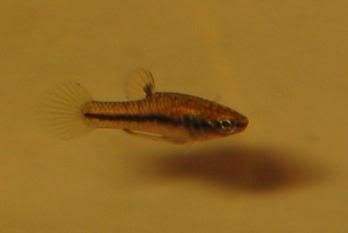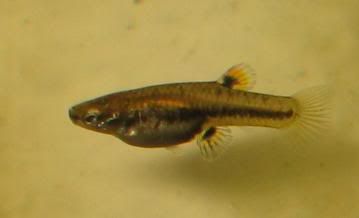FishProfiles.com Message Forums |
| faq | etiquette | register | my account | search | mailbox |
| For those who need it: How to tell Male from Female in Livebearers | |
So_Very_Sneaky             Ultimate Fish Guru Posts: 3238 Kudos: 2272 Votes: 201 Registered: 10-Mar-2004   | [font color="#800080"] So, you've decided to get an aquarium, you pick the one you like out, and bring it home. You set it up and wait 2 days, then off you go to buy fish. When in the fish store, you see these beautiful brightly colored active fish called Guppies. You find out from the salesman that these fish are Livebearers- meaning the mother fish gives birth to live young, just like mammals do! How fascinating you think! So you buy a set of 6. However, now you wonder, which ones are the boys and which are the girls. Well heres some ways to tell: With Guppy's the task can be relatively easy, Male guppys tend to have: A) Larger Tails B) More Colorful Tails and Bodies However, today with the breeding in place of these fish, females have gotten so colorful that if someone from 100 years ago came forward in time, they would mistake females for males! So, heres how you really tell male from female, and it works for all types of livebearers- Mosquito Fish, Guppys, Platys, Mollys, etc. Look at the farthest back fin under the belly of the fish, the anal fin. If it is big, round and hangs down, it is a female. female platy The same goes for guppies: female guppy and for female mollies: female molly On a male fish, this same fin is held tight to the body, points backwards, and is called a gonopodium. It is the same thing as a penis on mammals essentially. Male platy and the same for guppies, and mollies. male guppy male molly I hope this helps anyone who needs assistance in knowing how to pick the males from the females, espescially in species like mollys and platys who look identical, with the exception of size difference, which is not often obvious unless they are older.[/font] Come Play Yahtzee With Me! http://games.atari.com Http://www.myleague.com/yahtgames |
BabyBlueEyes      Hobbyist Posts: 105 Kudos: 110 Votes: 1 Registered: 10-Sep-2004   | Great job sneaky_pete! you have great info and great pics! this will sure help some confused peeps!  |
littlemousling      Conchiform Posts: 5230 Registered: 23-Aug-2003   | And the same runs for many of the less common livebearers - Male Heterandria formosa, with rather long gonopodium:  Female:  [/font][/font] [/font][/font]-Molly Visit shelldwellers.com! |
fishyhelper288           Fish Guru Posts: 2161 Kudos: 1951 Votes: 137 Registered: 29-Feb-2004 | little mouseling, where can u bye that fish?  it would be a nice addition to my tank it would be a nice addition to my tank its a 30 gallon understocked with 3 guppies, 3 swordtails, 5 plattys, 2 endlers, and i need a fish to fill in the rest, the numbers may change, i am going to seperate the males and females, so i get no unwanted fry after the females run out, and stop being pregonant its a 30 gallon understocked with 3 guppies, 3 swordtails, 5 plattys, 2 endlers, and i need a fish to fill in the rest, the numbers may change, i am going to seperate the males and females, so i get no unwanted fry after the females run out, and stop being pregonant the numbers will probly be, 1 guppy, 1 sword, 2 plattys, and i am going to be transfering no more than, 3 guppys, 2 swords, 6 platty fry (as u can see i love my plattys the numbers will probly be, 1 guppy, 1 sword, 2 plattys, and i am going to be transfering no more than, 3 guppys, 2 swords, 6 platty fry (as u can see i love my plattys ) and the endlers well will not be going into the 30, giving away the female, and fry, and then im keeping my male ) and the endlers well will not be going into the 30, giving away the female, and fry, and then im keeping my male |
littlemousling      Conchiform Posts: 5230 Registered: 23-Aug-2003   | I got mine shipped from a fellow hobbyist, they're often up on Aquabid. Great fish, absolutely TINY - females hit about an inch after a while but males are much smaller and they have such a low bioload even I, queen of understocking, would have no problem stocking them at about 5-7 fish per gallon. Great additions to most tanks. Fun fact: they're so small that bearing spawns of dozens of fish like other livebearers do just isn't possible, so they bear fry at different stages and can release a few a day once they really get going. And they're US natives, which is fun. -Molly Visit shelldwellers.com! |
$horty         Fingerling Posts: 35 Kudos: 25 Votes: 22 Registered: 30-Jan-2005   | I am very confused now. I have only one livebearer Molly. She was in the tank with 6 neon tetras, 2 ghost shrimp, and 2 ADFs. The morning after I bought the neons, ADFs, and the Molly I found 6 fry. The only fry these fish could possibly belong to is the Molly. The part that is confusing to me though is that my Molly looks like the picture of the male molly, not the female. Her fins are very short and very close to her body. So by looking at the pictures from the first post of this thread, my molly should be a male. Where did the fry come from? Neon tetras are not livebearers are they? |
littlemousling      Conchiform Posts: 5230 Registered: 23-Aug-2003   | Don't look at all of the fins, just the anal fin. If there's a full anal fin, it's a female. If it's a tube, called a gonopodium, it's a male. Of course yours is a female, but I hope that clarified it for you. Females' anal fins may appear at first glance to be gonopodiums if they're held against the body. -Molly Visit shelldwellers.com! |
Calilasseia    *Ultimate Fish Guru* Panda Funster Posts: 5496 Kudos: 2828 Votes: 731 Registered: 10-Feb-2003   | Extreme examples of this difference can be found in fishes such as Phallichthys isthmensis, whose taxonomic name translates as 'Fish with a phallus from the isthmus (of Panama)'. Males in this species have a gonopodium that is huge in relation to the size of the fish: in exceptional specimens it can extend beyond the caudal peduncle. The venerable Innes book has a good (albeit black and white) photograph of this species in which this trait is very clearly visible. Several other Poeciliid livebearers also exhibit large gonopodia in the males: Poecilistes pleurospilus is another, though less extreme, species in this regard. Incidentally, just to sow confusion in the ranks, the presence of a gonopodium, while not unique to the Poeciliid livebearers, is principally diagnostic to that Family. There are other livebearers belonging to other Families that have gonopodia, including the truly astonishing Four Eyed Fish Anableps anableps, and the One Sided Livebearer Jenynsia lineata. Both of these fishes have a 'handed' gonopodium that can only swivel in one direction, and the females have a genital pore covered by a scale that likewise can only swivel to reveal the pore in one direction. Thus, "left-handed" males can only mate with "right-handed" females and vice versa. Then there is the Family Goodeidae, which includes fishes such as Skiffia bilineata, Ameca splendens and others, in which the male reproductive modification involves a partial separation and thickening of the foremost rays of the anal fin, the remainder of the fin remaining similar in shape to that of the female. In Goodeid fishes, the appearance of a deep split in the anal fin, with thickened front rays separated from the rest of the membrane, is the diagnostic feature that separates males from females. Anyone wishing to give Ameca splendens a try as a livebearer with a difference would do well to visit this page: Ameca splendens Article Just to let you know that livebearers are pretty diverse, and that the rules that apply to the "Big Four" (Guppies, Mollies, Platies, Swordtails) only apply in general to other members of the Family Poeciliidae. And that's before we begin to consider other 'livebearing' fishes such as the Halfbeaks, but they are best left to the more experienced aquarist anyway for a host of reasons.  |
fishys_cant_fly Hobbyist Posts: 138 Kudos: 114 Votes: 2 Registered: 22-Dec-2005   | I love the pics  . . P.S. Platys are the best!  |
ashley1984 Small Fry Posts: 8 Kudos: 4 Votes: 3 Registered: 23-Oct-2007   | hey thanks sneaky the info provided is very usefull!!! any info on albino sharks and golden danio?????? 1 oscar 1 c,a,e 2 plecos 48" x 24" x 18" filtration= 1 fluva2+ 1 fluval 3 and a aqua pro 3 heating= 2 300w superfish heater with thermo |
EvilE Fingerling Posts: 17 Kudos: 7 Votes: 0 Registered: 09-Dec-2007   | good info--and photos-thanks! |
| gzeiger Small Fry Posts: 1 Kudos: 0 Votes: 0 Registered: 24-Oct-2008 | Those Heterandria are quite ubiquitous here in South Carolina. It's an interesting coincidence that you mentioned them. I've been keeping some wild-caught ones, trying to figure out what they were, so today I learned their name  They're extremely easy to keep. They seem to handle water temperatures from about 70-90F (ba |
| LaurenJ Small Fry Posts: 6 Kudos: 6 Registered: 29-Jan-2012    | When I lived in Florida I would catch those little Heterandria formosa in the canal behind my parent's house. There were also wild Mollies, and these cute little black and white spotted male livebearers. Looked like guppies. (not to mention the big fish, alligator gar, paddle fish, HUGE plecos..) |
| Jump to: |
The views expressed on this page are the implied opinions of their respective authors.
Under no circumstances do the comments on this page represent the opinions of the staff of FishProfiles.com.
FishProfiles.com Forums, version 11.0
Mazeguy Smilies